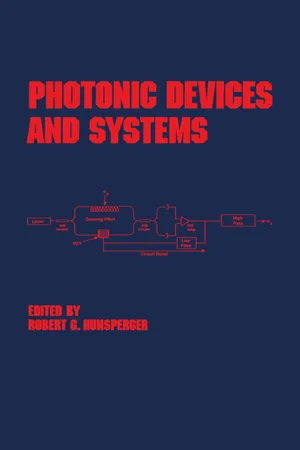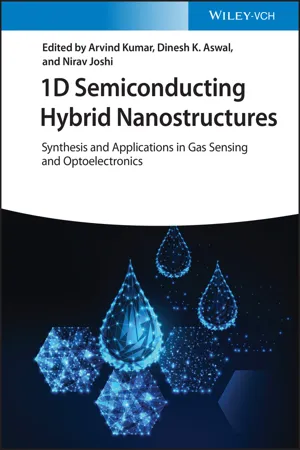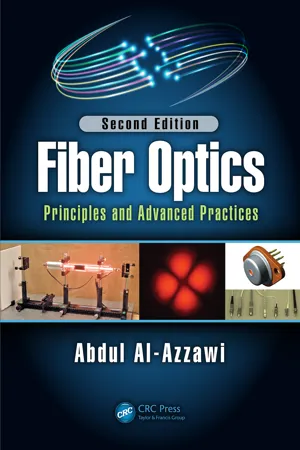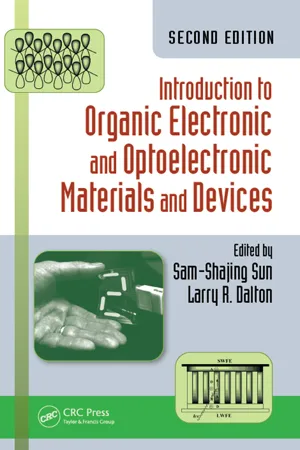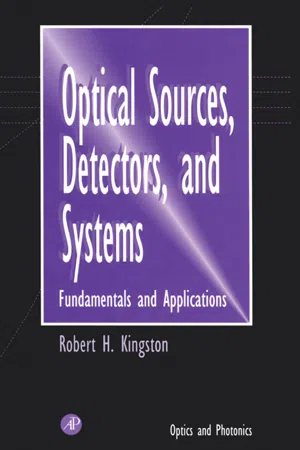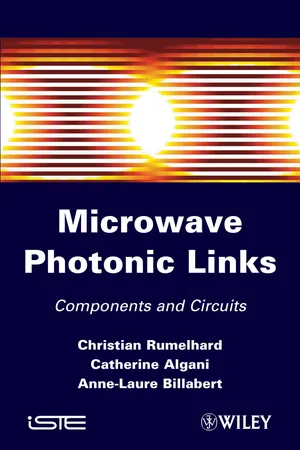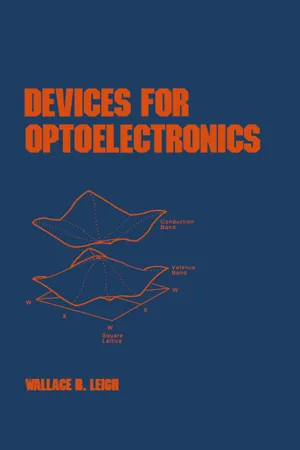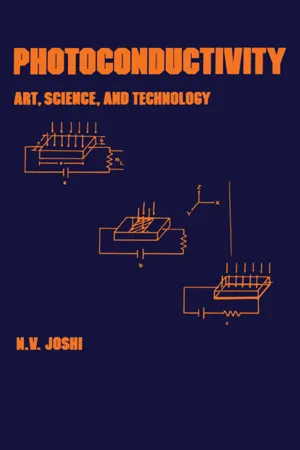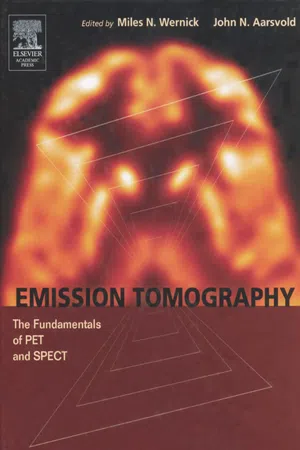Physics
Photodiode
A photodiode is a semiconductor device that converts light into an electrical current. When photons strike the photodiode, they create electron-hole pairs, generating a flow of current. This process is used in various applications, including light detection, solar cells, and optical communication systems.
Written by Perlego with AI-assistance
Related key terms
Related key terms
1 of 4
Related key terms
1 of 3
10 Key excerpts on "Photodiode"
- eBook - ePub
- Robert G. Hunsperger(Author)
- 2017(Publication Date)
- Routledge(Publisher)
Section VI we examine various applications for optical receivers.A. Physics of PhotodiodesFigure 1Attenuation or loss in dB/km of silica glass fiber versus wavelength. The minima occur at 1.3- and 1.55-μm wavelengths, which are therefore used for telecommunications.The function of a photodetector is to convert incoming modulated light energy into modulated electrical current. Light incident on a semiconductor photodetector is absorbed, and if the photon energy is greater than the bandgap energy, electron–hole pairs are generated. These carriers, created in a region of high electric field within the depletion region of the device, are swept out by an applied reverse bias, resulting in a photocurrent.In photomultipliers, vacuum photodetectors, and phototubes, electrons are excited by photons over the energy barrier, or work function, of the material and become free electrons in a process called the external photoeffect [1 ]. Semiconductor Photodiodes operate on a principle known as the internal photoeffect, where the electrons and holes excited by the photon to higher energy levels remain within the material and contribute to photocurrent. The incident photon absorbed by the semiconductor generates a free electron that is excited from the valence to the conduction band, while a hole is generated in the valence band as shown in Fig. 2 . The carriers created in the depletion region drift in opposite directions as they are separated by the electric field, and carriers created within a diffusion length of the depletion region diffuse to the edges of the region and are collected. Under reverse bias, the carrier drift in the electric field induces a photocurrent in the load, RL . In Fig. 3 the valence band energy and conduction band energy are shown for p- and n-type semiconductor materials, and the drift and diffusion of the carriers are illustrated [1 ,3 - eBook - ePub
1D Semiconducting Hybrid Nanostructures
Synthesis and Applications in Gas Sensing and Optoelectronics
- Arvind Kumar, Dinesh K. Aswal, Nirav Joshi(Authors)
- 2022(Publication Date)
- Wiley-VCH(Publisher)
There are three types of PDs: Photoemissive Photoconductive Photovoltaic PN junction photodetector PIN Photodiode Avalanche Photodiode PDs are typically employed as an optical receiver, converting light signals that strike a junction into voltage or electric current. The light photons are absorbed by an illumination window with an anti‐reflect coating. In the depletion area, photon absorption results in the formation of electron–hole pairs. Photodiodes and phototransistors are examples of PDs. Solar cells, which collect light and convert it to energy, are another optical device comparable to photodetectors. The LED is a comparable but distinct optical device that works in the opposite direction of a Photodiode, converting voltage or current to light instead of light to voltage or current. The photoelectric effect, which is the action of light on a circuit, is the principle that applies to PDs. Max Planck was a German physicist who, in 1900, found that energy is radiated in small discrete units known as quanta; he also discovered the Planck's constant, which is a universal constant of nature. Planck's discoveries gave rise to quantum mechanics, a new branch of physics based on the equation E = hv, which is Planck's constant multiplied by the frequency of radiation. The photoelectric effect occurs when light strikes a metal surface in a vacuum, causing electrons to be expelled from the surface. This explains the basic theory of light energy that enables PDs to work. PDs are extensively employed in houses as safety devices in the form of smoke detectors, as well as in security systems alongside other optical devices. Figure 13.2 shows the general working principle of PDs. Covalent bonds are ionized when a light is used to illuminate the PN junction. This produces electron and hole pairs. The creation of electron–hole pairs produces photocurrents. When photons with energies more than 1.1 eV collide with the diode, electron–hole pairs emerge - eBook - ePub
Fiber Optics
Principles and Advanced Practices, Second Edition
- Abdul Al-Azzawi(Author)
- 2017(Publication Date)
- CRC Press(Publisher)
i) in the external circuit, generated by this movement, is given by
where:i( t )= −Q Wv( t )(9.5) t is the timeQ is the total charge of the photo-generated electronsIf the voltage is increased the electron velocity increases, therefore increasing the current. This means that for an input light pulse, the output current pulse will have a faster response time for a higher applied voltage.Response time can be affected by dark current, noise, responsivity linearity, back-reflection and detector-edge effect. Edge effect occurs because detectors only provide a fast response in their centre area.FIGURE 9.5 Generated electron-hole pair at position x.9.4.4 SENSITIVITYA photodetector is a device that converts photon energy into an electrical signal. A photodetector usually detects the energy of some photons better than others. Detection sensitivity is a function of the photon's energy being detected. The sensitivity is usually given as a function of the wavelength, and expressed as the QE. A high sensitivity allows a low level of light to be detected.9.5 TYPES OF OPTICAL DETECTORSThere are many types of optical detectors including the phototransistor, photovoltaic, metal-semiconductor-metal (MSM), pin Photodiode and avalanche Photodiode (APD). These detectors are explained in the following sections.9.5.1 PHOTOTRANSISTORSPhototransistors are the simplest type of photodetector. The basic operating principle of a phototransistor is shown in the cross-section in Figure 9.6 . The device consists of an n-p-n junction, in which n is the emitter, p is the base and the other n - Sam-Shajing Sun, Larry R. Dalton, Sam-Shajing Sun, Larry R. Dalton(Authors)
- 2016(Publication Date)
- CRC Press(Publisher)
DC creates a variation of the output power. This principle is used for electrooptic signal conversion in optical communication applications. On the other end, a photodetector can be employed for conversion of the optical signal back into the electrical domain.FIGURE 2.24 Mach–Zehnder modulator.FIGURE 2.25 Modulator transmittance function T(V).2.7 SUMMARY
Semiconductor optoelectronic devices are traditionally based on absorption and generation of photons by electron–hole pair generation and recombination, respectively. As the photon generation can be spontaneous or stimulated, three basic types of devices are distinguished: photodetectors, LEDs, and lasers. Photodetectors transform light into electrical current (photocurrent). Photodiodes are operated at reverse bias; their performance is mainly characterized by the responsivity spectrum (Figure 2.4 ). Solar cells generate a forward bias (photovoltage) and electrical power; their main parameters are the open circuit voltage, the short circuit current, and the fill factor (Figure 2.7 ). The key effect in photoconductors is the electrical conductivity enhancement due to illumination; their photocurrent is proportional to the applied voltage (Figure 2.10 ). LEDs transform electrical current into noncoherent light (Figure 2.11 ); their efficiency is often limited by total internal reflection (Figure 2.12 ). Laser diodes are the most sophisticated optoelectronic devices, which require carrier inversion and optical feedback to reach the lasing threshold (Figures 2.14 through 2.16 ). Threshold current, slope efficiency, and modulation bandwidth are key laser parameters (Figures 2.17 and 2.18 ). Variations of the refractive index inside the device are often employed to confine and guide the optical wave within a small region of the size of the wavelength. Discrete waveguide modes are shown in Figure 2.22 . The propagation velocity of the wave can be modified by applying an electric field that changes the refractive index of the waveguide. This principle is employed in electro-optic modulators to vary the intensity or the phase of an optical wave (Figures 2.24 and 2.25- eBook - ePub
Optical Sources, Detectors, and Systems
Fundamentals and Applications
- Robert H. Kingston(Author)
- 1995(Publication Date)
- Academic Press(Publisher)
Chapter 5Real Detectors: Vacuum Photodiodes and Photomultipliers, Photoconductors, Junction Photodiodes, and Avalanche Photodiodes
The ideal photon detector we have discussed is an excellent model for many real detectors, except that we must consider in detail the expected capacitance, the frequency response, and the spectral behavior of the quantum efficiency. We first consider the vacuum Photodiode and photomultiplier, the latter having adequate internal gain or electron multiplication such that amplifier noise is not a limiting factor. Unfortunately, the photoelectric effect used in such devices is only efficient at near-visible and shorter wavelengths and, beyond about a 1-μm wavelength, internal electron excitation in a semiconductor is the only available alternative. This class of detectors includes photoconductors, basically resistances whose values change with illumination, and semiconductor Photodiodes, where the reverse or saturation current is controlled by the incident radiation. Photodiodes may also be operated in the “photovoltaic” mode where the open-circuit voltage is a measure of the incident power, a small-signal version of the solar cell. Again, a device such as a semiconductor diode is close to the ideal photon detector but still suffers from the limitations of amplifier noise. We conclude the chapter with a discussion of the “avalanche” Photodiode, which supplies internal electron gain, thus offering in some cases marked improvement over the simple diode.Although we are discussing real detectors with performances approaching ideal “photon” counting, the reader is reminded that there are a family of simple though far less sensitive devices known as “thermal” detectors. These include bolometers, thermocouples, and pyroelectrics, which exhibit a resistance or voltage output which is a function of the temperature of a small sensing element that is in turn heated by the incident optical or infrared radiation. (Kingston, 1978 - eBook - ePub
Microwaves Photonic Links
Components and Circuits
- Christian Rumelhard, Catherine Algani, Anne-Laure Billabert(Authors)
- 2013(Publication Date)
- Wiley-ISTE(Publisher)
Chapter 4Photodetectors
4.1. Photodetector definition
Regarding photodetectors, it is possible to speak of current response in units of incident optical power.In the first English texts concerning optoelectronics, current response as a function of optical power (A/W) of a photodetector was called sensitivity . This significant term was gradually replaced by responsivity , which more specifically describes the sensitivity of a photodetector. This nomenclature will be adopted in this text.For photodetectors, it is also possible to speak of quantum efficiency, expressed as:[4.1]with:–np =number of electron-hole pairs generated per second;-φ = number of incident photons per second.The relation between quantum efficiency and responsivityRpdin A/W is:[4.2 ]with:– q= electron charge = 1.602×10-19 C;– h = Planck’s constant = 6.626×10-34 J/s;ν= light wave frequency in hertz.Responsivity takes into account the frequency of the light wave. Consequently, by referring to Table 5.1 , it should be noted that for a quantum efficiency of 100%, the responsivity of an optical photodetector at 1.55 µm is 1.25 A/W, whereas to obtain identical quantum efficiency the responsivity of a photodetector at 0.8 µm is only 0.64 A/W.In the sections below, quantum efficiency notion is used for Photodiodes, while responsivity is used for phototransistors. It is nonetheless possible to go from one to the other through equation [4.2] .4.2. Photodiodes
4.2.1. Presentation
After having been transported by an optical fiber, the amplitude-modulated light flux (or Intensity Modulation) must be demodulated. Amplitude-modulated photodetection (or Direct Detection) is sufficient to detect a modulated microwave frequency or an ultra-wide band signal. This photodetection can be performed by Photodiodes or phototransistors. Phototransistors shall be considered in a subsequent section, whereas Photodiodes are considered below.Optical absorption, i.e. the transformation of photons in electron-hole pairs in different semiconductors assumed to constitute Photodiodes, is first considered. The varying configurations of different Photodiodes will be reviewed and an equivalent electrical model to these components will be detailed. Nonlinearities and their origins will then be considered and how UTC diodes push the limits of these nonlinearities will be discussed. An outline of the different configurations allowing maximum frequency operation of these components is provided. Finally, different configurations allowing an increase in quantum efficiency are presented. - eBook - ePub
- Wallace B. Leigh(Author)
- 2021(Publication Date)
- CRC Press(Publisher)
p-n junction interface.Details of Photodiode characteristics will be covered in Sections 6 and 7, but parameters relevant to all photodetectors will first be reviewed.Figure 3 Basic photoexitation and drift of carriers in a p-n Photodiode.Figure 4 Spectral response of absorption coefficient for a variety of direct and indirect-band-gap semiconductors. (From Ref. 1 .)Figure 5 Structure of (a) a p-n and (b) a p-i-n Photodiode.4 BASIC PHOTODETECTOR CHARACTERISTICS
Most photodetection devices are classified by four attributes: sensitivity speed, overall efficiency, dynamic range. Sensitivity is determined by responsivity. Responsivity is measured as rms output current or rms output voltage per incident optical power, measured in amps/watt or volts/watt. For photoconductors and Photodiodes operating in a photoconductive mode, an average photocurrent is measured and can be expressed asI p=qη iP ph v(4) where Pp is the incident optical power and ηi is the internal quantum efficiency, or the probability that an incident photon results in the generation of a detectable free carrier. The responsivity of the device isR ==I pP pqη ih v(5) The efficiency ηi , is mainly a function of the absorption coefficient and, hence, depends on the operating wavelength and depth of the absorption.Other pertinent detector figures of merit besides the responsivity include the noise equivalent power (NEP), which is defined asNEP =noise responsivity=radiant power signal/noiseor the optical power where the signal-to-noise equals unity. The NEP defines the minimum optical power the detector is capable of measuring. The specific detectivity D* is also a measurement of minimal power capabilities, corrected for the area A of the detector and the bandwidth B - Eduard Säckinger(Author)
- 2017(Publication Date)
- Wiley(Publisher)
Chapter 3 PhotodetectorsThe first element of an optical receiver is the photodetector. The characteristics of this device have a significant impact on the receiver's performance. To achieve a good receiver sensitivity, the photodetector must have a large response to the received optical signal, have a bandwidth that is sufficient for the incoming signal, and generate as little noise as possible.We start with the three most common photodetectors: the p–i–n photodetector, the avalanche photodetector (APD), and the optically preamplified p–i–n detector, discussing their responsivity, bandwidth, and noise characteristics. Then, we turn our attention to photodetectors that are suitable for integration in a circuit technology, in particular, detectors compatible with CMOS technology (silicon-photonics detectors). Finally, we explore detectors for phase-modulated optical signals, such as QPSK and DQPSK, including the coherent detector with phase and polarization diversity.3.1 p–i–n Photodetector
The p–i–n photodetector (or p–i–n Photodiode) shown schematically in Fig. 3.1 (a) and (b) is one of the simplest detectors. It consists of a p–n junction with a layer of intrinsic (undoped or lightly doped) semiconductor material sandwiched in between the p- and the n-doped material. The junction is reverse biased with to create a strong electric field in the intrinsic layer. The light enters through a hole in the top electrode (anode), passes through the p-doped material, and reaches the i-layer, which is also known as the absorption layer. The photons incident on the absorption layer knock electrons from the valence band to the conduction band creating electron–hole pairs. These pairs become separated by the strong electric drift field with the holes traveling to the negative terminal and the electrons traveling to the positive terminal, as indicated in Fig. 3.1 (a). As a result, the photocurrent appears at the diode terminals. Figure 3.1- eBook - ePub
Photoconductivity
Art: Science & Technology
- N V Joshi(Author)
- 2017(Publication Date)
- Routledge(Publisher)
6 Modern Photodetectors 6.1. INTRODUCTIONPhotodetectors or photosensors have played a crucial role in military science and technology (particularly infrared detectors) for several decades. Their applications are also evident in diverse industries where switching with light intensity is employed. The principle of photoconductivity is used in various devices such as smoke detectors, solar energy cells, sensors, radiation, and electromechanical choppers. There is no limit to the practical applications, and now the importance of photodetectors is increasing because of the proliferation of optical communications. Because of recent technological developments, monolithic integration of ultrahigh-speed photonic devices has become a reality and the design of optical computers is the next logical step.The variety of advanced applications demands the imposition of stringent requirements regarding performance, ultrahigh speed, detectivity, spectral response, and overall compatibility. It is not easy to meet these requirements, but in the majority of cases modern photodetectors do. Photodetector technology is growing fast to match the needs of the future.Several comprehensive review papers and books on photodetectors can be found in the literature [1 , 2 , 3 , 4 , 5 , 6 , 7 ]. In this short chapter, no attempt is made to cover all the aspects of this field or all the materials used in photodetectors. Primary emphasis is given to modern photodetectors developed in conjunction with superlattices or quantum well structures. However, in order to achieve a coherent treatment, basic principles and the role of the important parameters involved in the process are also discussed briefly.6.2. PHYSICAL PRINCIPLES OF n-p JUNCTIONSThe basic theory of joining n and p regions (nondegenerate) in the same semiconductor was first systematically presented in 1949 by Shockley [8 ]. However, there is evidence that some efforts were made to understand junction properties before this [9 ,10 ] and even before the World War II.* - eBook - ePub
Emission Tomography
The Fundamentals of PET and SPECT
- Miles N. Wernick, John N. Aarsvold(Authors)
- 2004(Publication Date)
- Academic Press(Publisher)
Sze, 1985 ). Two different cut-off wavelengths are important: the upper cut-off wavelength (1.1 μm in silicon) and the short wavelength cutoff. The upper cut-off wavelength is defined by the band gap energy and the short wavelength cut-off is caused by the very high absorption coefficient at low wavelengths. Photons are mostly absorbed close to the detector surface in this case, but not in or close to the pn-junction. Thus they cannot contribute to the signal. Light with a wavelength within these limits produces the sufficient photocurrent in the diode.The quantum efficiency of a semiconductor diode depends on the following factors:• Light reflection and absorption at the glass or epoxy protection layer of the diode. • Light absorption in the passivation layer. • Light loss due to reflection on the diode surface. • Light loss due to recombination in the p-layers. • Absorption coefficient of the material.The charge collected in the semiconductor detector is too small without further amplification. Therefore, preamplifiers are used directly between the detector and the pulse analysis electronics. In general, there are two types of preamplifiers: the current-to-voltage converter and the charge-sensitive preamplifier. Both convert the charge Q in from the detector into a voltage signal. The output signal U out of a current-to-voltage converter is:(6)thereforeUoutdepends on the detector’s capacitanceCd .Because the capacitance of a diode is inversely proportional to the depletion depth, which is a function of bias voltage, a preamplifier with a conversion factor independent of the detector capacitance is an advantage. For a charge-sensitive preamplifier, the output voltage is proportional to the total integrated charge in the pulse (see Figure 5 ). The output signal U out of the charge-sensitive preamplifier is determined by the input charge and the feedback capacitor Cf. Based on this and the fact that integrated current-to-voltage amplifiers tend to oscillate with fast signals, most applications use charge-sensitive preamplifiers. The signal rise time of a Photodiode-preamplifier detector is determined by the preamplifier (transconductance and capacitance of the preamplifier’s input device) and the detector capacitance of the Photodiode. Figure 6 shows the output signal of a LSO-APD detector read out by a fast charge-sensitive preamplifier with a rise time of 30 ns. In combination with the LSO scintillator, the resulting signal rise time is approximately 60 ns. Compared to the LSO-PMT detector, which is used without an amplifier, this is 10 times slower. The signal decay time in Figure 6 is determined by the feedback resistor and the feedback capacitor of the preamplifier (see Figure 5
Index pages curate the most relevant extracts from our library of academic textbooks. They’ve been created using an in-house natural language model (NLM), each adding context and meaning to key research topics.
Explore more topic indexes
Explore more topic indexes
1 of 6
Explore more topic indexes
1 of 4
